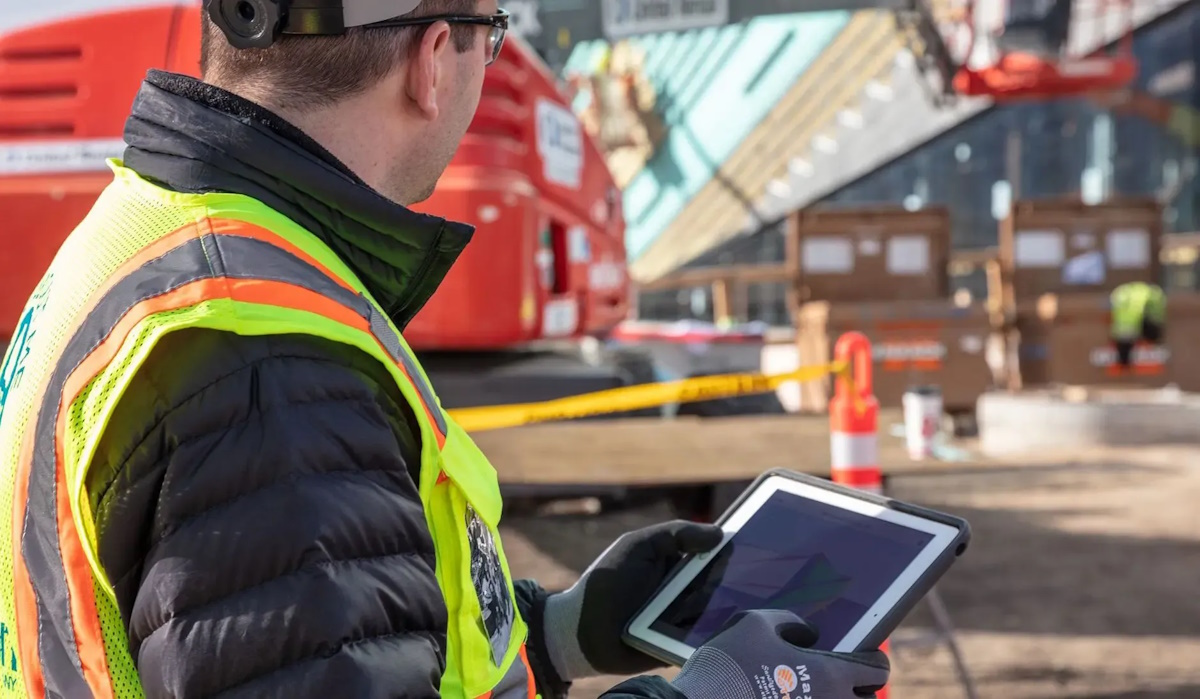Q&A With Mark Egan, SIS Director of Sales UK | Ireland
Interview by: Sarah D. Morgan, SIS Senior Marketing & Brand Manager | Feature Writer

In this article, THESIS Q&A covers Mark Egan, UK SIS Director of Sales, on ERP visibility. In our conversation, Mark highlights the importance of visibility and how with no visibility in these current times, construction businesses must modernise or die. A groundbreaking message published in the landmark book, Modernise or Die, in 2015 by, Mark Farmer. Mark Egan is a unique messenger of Mr. Farmer’s research and his truth as someone who has worked in the field and the back office of construction sales. He now evangelises the importance of 360-degree visibility in modern software solutions.
Q: Hi Mark, tell us about yourself and how you became a Director of Sales at SIS UK in the construction solution industry.
A: I’ve worked in sales for 25 years. I started in FMCG and commercial sales for several years before moving into sales manager roles selling construction products in 2007 including lighting, HVAC, and fixings products. In doing this, I met contractors on five building sites daily for site surveys, which gave me an understanding of construction processes. More importantly, this work educated me about the pain’s contractors face. In 2015, I moved into construction ERP software to help solve those on-site and back-office inefficiencies. Here, I was uniquely able to translate what I’ve learnt and solve problems with modern software.
I joined SIS to expand Dynamics 365 and SIS Construct 365, to the UK and Europe. It is based on time spent at my previous employer, 4PS, utilising my expertise and understanding of construction processes, along with my Microsoft experience and knowledge. I also joined SIS because there is a unique opportunity for construction ERP solutions like SIS Construct 365 in Tier 1 businesses with the Microsoft Dynamics 365 platform. Options are limited today for companies of that size in the UK, with no other Microsoft options. Here I can leverage my combined expertise in this market, understanding, and promoting increased visibility, thus higher profits, and efficiency for the industry I have so long enjoyed and had so much success serving.
Q: When you say visibility in construction, what is your meaning, and why is it important?
A: Visibility can have various meanings in construction, such as a Project Manager having visibility on a site or a CFO having the information and data to make critical strategic decisions at the right time. Here are examples of visibility in construction:
- Information is shared across and between multiple departments such as H&S, Preconstruction, Contracts, and Finance.
- Site visibility in the literal sense of being able to see which employees such as subcontractors are on site, and what are the site conditions.
- Project programme and progress visibility.
- Resource visibility and availability.
- Material visibility could mean not ordering more items or plant and equipment if you have data on what is available at other sites, warehouses, and yards.
Overall, construction struggles the most with financial visibility at both a project level and at head office level.
Q: What does visibility mean to senior leaders?
A: From my meetings with construction business leaders over the years, most say they want to improve visibility and control but struggle to achieve them. With better visibility, they then have more control. That could be control over the project programme, project budgets, and ultimately, project and company profitability.
Q: Why is it important to improve visibility?
A: It has never been so important as this moment in this UK construction market, where many contractors are having financial difficulties. In a presentation I saw recently at a summit for construction leaders – it said that 18% of all businesses in the UK that had become insolvent in 2023 were from the construction sector. Almost one-fifth from construction. That is not sustainable, and that is why visibility is so important. That is not just small businesses either. Three high-profile cases of companies with more than £400m in turnover were affected. This is when banks and credit insurers are nervous about the industry, which means contractors must improve finances and give confidence back around the sector.
Q: Why is complete visibility so challenging to achieve?
A: Fast-paced projects make it difficult to track costs and spending, especially when unplanned. Rising material and labour costs affect this, including dispersed stakeholders on various sites and offices.
This is because construction has historically been poor at adopting digital methods; therefore, little data is collected. Most information was collected in paper records or spreadsheets, which is then difficult to compare or benefit from, especially as it’s predicted that 90% of spreadsheets have errors.
From a software perspective, disparate systems need to integrate so data does not become lost and siloed between departments.
Q: What benefits can businesses realise from better visibility?
A: Here is a comprehensive list of benefits businesses can realise:
- Better Collaboration – information such as spend, or accrued costs can be shared between departments to avoid errors or miscommunication.
- Better Predictability – having complete visibility of costs means the financial outcome of a project is more predictable earlier in the programme.
- Efficient Workflows – improved flow of data and approvals will lead to better efficiency and less errors, which could be costly.
- Ability to Pivot and Make Changes Quickly – with better visibility of costs, if there is an overspend in one area that is spotted sooner, a commercial manager can take decisive action to realign and maintain budgeted spend and margin.
- Real-time Information – More often than not, if data exists in construction, it becomes delayed, meaning decisions are based on information that may not be valid or correct.
- Improved Communication – Both internally and with clients and the supply chain – If information is visible and shared quickly between stakeholders, relationships can be improved, which usually reduces delays that occur during disputes.
- Remove Silos Between Departments – Very often, information is contained within a department, and work needs to be duplicated. For example, a user can spend hours estimating the stage, which repeats when a contract is won. Continuous data flow saves re-calculations.
- Avoid Costly Delays – Work on site can halt when disputes occur between the main contractor and subcontractors. Variation orders can often cause this due to confusion over agreeing to additional If variation orders are tracked and communicated effectively, disputes can be reduced.
- Single Source of Truth– Contractor departments often work from various documents or systems, so it isn’t easy to see which information is correct. Integrating this information into simple but effective BI visualisations means decisions are made based on the proper data.
- Avoid Project Overrun and Over Budget – The last reported figure in Arcadia’s global construction dispute report was almost £30m in average dispute value, and the average project overrun was nearly 12 months. That is low compared to other parts of the world.
- Reduce Waste to Improve Environmental Credentials – Avoid overordering of materials, which, in addition to extra costs, usually go to waste rather than being used on other sites.
- See trends and improve predictability – by trade, by subcontractor history, to judge the performance of subcontractors, or to see payment history to decide whether it is worth pursuing a project with a particular client. Further than that, see a complete history of projects you have bid and tendered for so you can see trends and the percentage chance of winning a project based on suitability of work, vertical market success, location, etc.
Q: What advantages would this give to contractors over their competitors?
A: Improved efficiency allows a contractor to be more competitive whilst still achieving higher margins.
Better predictability means they can give confidence to potential clients, as historical data from earlier projects can prove their capabilities and strengths when bidding on new work.
Greater visibility allows colleagues to make the right decisions quickly, which reduces stress and could help them attract and, more importantly, keep staff. The labour shortage is high in the UK construction market, so the ability to keep good people in the business provides stability and a distinct advantage over competitors to retain clients for future projects.
Q: What are the consequences of not improving visibility?
A: There are many potential consequences with varying degrees of severity: financial losses, H&S accidents, and client dissatisfaction, but the reality could be even worse. Mark Farmer published a groundbreaking UK construction review in 2015. The book is titled Modernise or Die. That is the sad truth of the matter.
Several companies are experiencing financial difficulty, and many companies of all sizes have folded in recent years. Larger companies are harnessing the power of data to varying levels. Still, the companies further down the supply chain are suffering the most and aren’t investing in technology as much as they could or should.
If we compare construction to other industries, many cases of traditionally strong businesses have disappeared because they allowed tech-driven new players to overtake them. This has affected many high-street retailers in the UK, which have fallen to online shopping giants. Those traditional retailers already had the customer base – they just needed to modernise to appeal to the modern buyer to keep that customer base, but didn’t, and died.
Then, look at companies like Nokia and, later, Blackberry. They had the mobile phone hardware market sewn up, but from nowhere, the likes of Apple and Samsung produced smartphones, and almost overnight, the others lost the market.
That will continue to happen in construction for those who do not modernise.
Q: How can Tier 1 construction businesses improve visibility?
A: If we refer to the examples of construction visibility above, these solutions below can help.
- Physical visibility can be improved using remote, live site camera providers like Evercam.
- Detailed information on resource competencies can improve resource visibility. Ensure the correctly qualified and competent individuals, teams, or subcontractors are mobilised on the right project. This is based on their experience and qualifications and can be specific to a particular type of project. This will lead to improved on-site efficiency, better work quality, and improved client satisfaction. Holding that accurate data centrally helps enormously.
- Material and equipment visibility can be improved by having accurate purchase history and inventory records visible to all. Often, procurement is done centrally through buyers who do not have visibility of what has already been ordered or delivered to the site. With real-time data recorded on-site that remote buyers can see, it ensures no duplication of orders and costs.
- Improvements in financial visibility require better and deeper data. More historical data gives multiple reference points and leads to improved decisions based on something other than guesswork or isolated information.
- Data collection happens via various software tools. Do they all talk? An integrated software solution on a modern platform can bring all that together. Our Microsoft Dynamics 365 with SIS Construct 365 solution allows Tier 1 contractors to do just that and fully end-to-end in the Cloud to improve security and integrations with other third-party software tools. At SIS, we want our clients to have the best overall solution and keep using the tools in the field they are happy with, but by bringing the data from that into the core finance system and keeping everyone at the regional or head office up to date with real-time data.
Q: What does visibility look like in the future of construction?
A: In fact, the future is now if you work with the right partners using AI—automated risk assessments, accurate project progress reports, AI-powered tenders based on historical data, and successful bids are available. In these examples, AI improves H&S by spotting potential risks early, provides instant progress reports for clients, and can win you more work with far fewer person-hours manually compiling bids and tenders.
Automation will mean using digital tools that provide data at all process stages. For example, robotic brick layers have been trialled.
Modern Methods of Construction (MMC) allows for visibility into progress at various project stages. For example, when a unit/object is completed at the manufactured stage, it is easier to quantify and see the progress of the installation on site.



